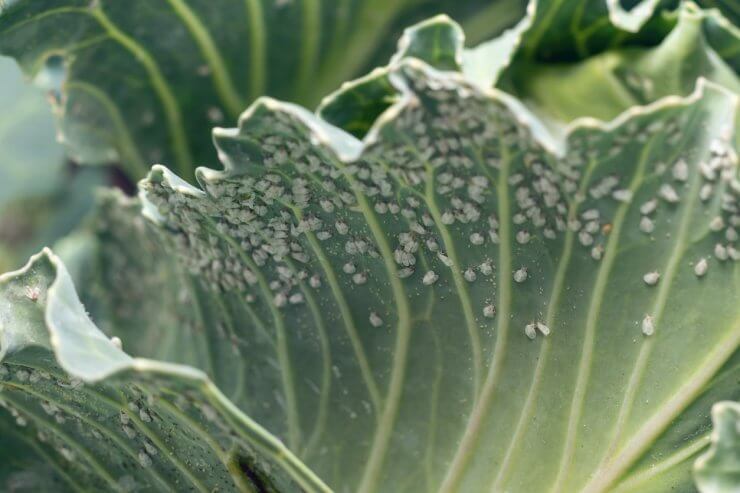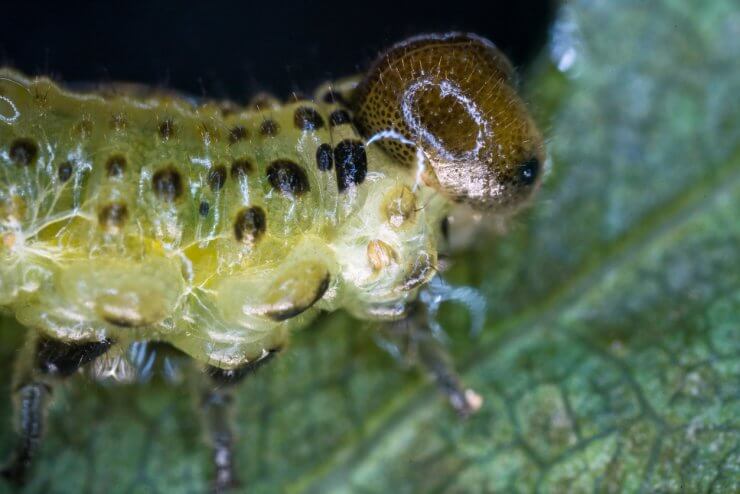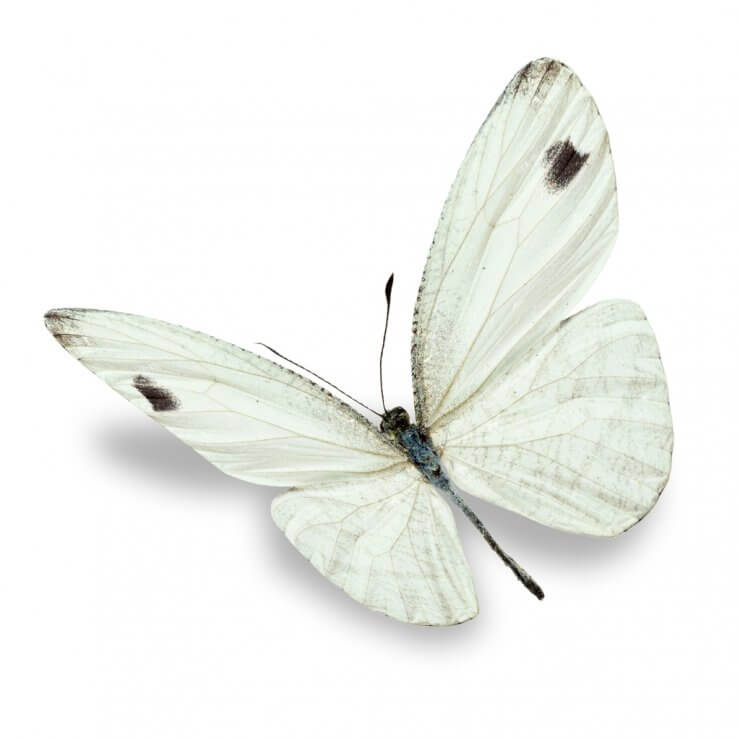
Cabbage whiteflies
Vigilance is your best weapon in the fight against cauliflower pests. If you see discoloration, wilting, holes in the leaves, damage to stems or roots, or insect infestation or eggs, take immediate action. Pests can reduce leaves to skeletons and then burrow into heads, while others attack at the root level. And pests are a primary source of disease spread.
Spot the symptoms of cauliflower pests
Check heads, leaves, and stems for these symptoms that come from pests on the prowl.
| Pest | Symptom |
| Small holes in leaves between veins | Cabbage loopers |
| Eggs underneath the leaves | Cabbage moths |
| Wilting leaves with bluish or yellow cast; shriveling plants | Cabbage root fly/maggots |
| Yellowing leaves; clusters of small “bumps” on underside of leaves | Aphids |
| Shallow grayish markings on leaves; small green worms with stripes | Cabbage white butterfly |
| Honeydew on leaves; eggs on underside of leaves | Cabbage whiteflies |
| Shallow holes in leaves that don’t go all the way through | Flea beetle |
Here are some of the pests you may encounter:
Cabbage looper

Cabbage looper
This is a leafeater that can chew a crop to bits before you know it. It’s a green caterpillar with an inchworm-like movement and a white stripe. Adults are brown moths with a silver figure-eight on the wings. Eggs are laid on the undersides of leaves and are domed and ridged.
Treat cabbage loopers with Bacillus thuringiensis (Bt), or douse plants with regular white flour (not self-rising). Dew on the flour will lead to petrified bugs that you can rinse off the following day.
Cabbage moth
This moth with a white diamond on its folded brown wings has a larva that’s as voracious a feeder as the adult moth is. When you see a moth, look for eggs underneath the leaves.
Unfortunately, the cabbage moth has developed a resistance to some pesticides. Try Bt or neem oil, but a better bet is parasitic wasps. Again, companion planting, in this case, collard greens, can lure the critters away from your cauliflower crop.
Cabbage root fly/maggots
Maggots are larvae that turn into cabbage root flies. They’re tough to control because they hatch and feed underneath the soil, so you may only know they are there by the appearance of stunted growth or wilted foliage. They are more common in northern climates.
Like most maggots, these critters group together in clumps of white, legless maggots about 1/3 of an inch long. They feed voraciously on root systems of cole crops. The cabbage root fly resembles a small house fly and feeds on plants for about 10 days before laying eggs at the plants’ base. You might spot eggs laid in rows at the base of plants.
Plants attacked by flies and maggots inevitably die. But if you see flies around your plants, look for eggs in the soil and destroy them. Try applying diatomaceous earth (DE) on the ground to discourage egg laying. Dig down to examine the roots of plants showing distress and discard victims.
You can also try live beneficial nematodes that you can buy online to attack soilborne pests. Alternately, try installing “cabbage collars” of cardboard around the base of the plant to prevent egg laying. Then there are sticky traps for the flies, and you can plant radish as a trap for the maggots. Finally, you might be able to dig up your plants, swish the roots in cold water and allow the maggots to drown, then replant your cauliflower.
Practice crop rotation to avoid overwintering pupae, and till the garden in fall and spring to expose the pupae.
Aphids
The aphid is a tiny, sap-sucking critter that eats through leaves and flower heads. It spreads plant diseases and leaves a trail of honeydew that attracts other insects and promotes the growth of fungus. Look for eggs on the underside of leaves and tell-tale clumps of stacked-up aphids, or misshapen, curling, stunted, or yellowing leaves.
Rinse aphids away with a stream of water. You can also use neem oil to kill them, or dust plants with flour. You can also try spraying leaves with a mild soap solution in water, reapplying every two to three days for two weeks.
Prevent aphids with beneficial insects such as ladybugs, lacewings, or parasitic wasps. You can order these online and they’ll keep aphids controlled from the start.
Also, try companion planting to keep aphids away. They’re repelled by catnip and are attracted to mustard and nasturtium.
Cabbage white butterfly

Cabbage white butterfly
The cabbage white butterfly lays eggs that become hungry larvae. They’re also known as cabbage worms or imported cabbage worms, and they devour leaves and bore into lower heads, ruining a crop. The first symptoms are shallow, grayish markings in the leaves.
The larvae are velvety green worms with a few yellow stripes. They emerge from the butterfly’s eggs laid underneath leaves. Handpick the eggs if possible, or spray with BT every one to two weeks. Wash off any remaining pests after harvest with water and a small amount of detergent.
Cabbage whitefly
This is a tiny white fly with scaly nymphs that infest the undersides of leaves, feeding on leaf sap and excreting honeydew, which promotes sooty mold growth. Many growers simply put up with this pest because while it disfigures a plant’s leaves, it doesn’t damage the heads.
Flea beetle
There are two types of flea beetle: the crucifer flea beetle and the striped flea beetle. They have extra-large hind legs that allow them to jump like a flea. These insects chew holes in the leaves that don’t go all the way through the leaves.
There is no organic product to fight flea beetles, so try a pyrethrum spray, use row covers as protection, or try to time planting to avoid their peak feeding time in early summer. You can also try trap cropping using mustard as a first line of defense.
How to treat pests on cauliflower
Here are some proven ways to get rid of pests on your cauliflower. Choose the best treatment for the type of pests invading your trees.
- Pick off the pests. Use your garden gloves to remove the pests by hand. After removal, destroy pests by drowning them in a bucket of soapy water or crushing them with your foot. Handpicking isn’t efficient or practical for very small pests but works well with larger pests.
- Apply insecticidal soap. Insecticidal soap is organic. The potassium salts in insecticidal soap help remove an insect’s protective waxes, causing the destruction of insect membranes and killing them. Mix the soap with water to create your solution and apply directly to insects on any plants. While insecticidal soap is less apt to affect other organisms, certain plants might be sensitive to the soap and can suffer leaf burn.
- Apply horticultural oils. Combine plant- or petroleum-based oils with water to produce horticultural sprays. Neem oil, for instance, is derived from seed extracts of the neem plant. Oil-based sprays block an insect’s air holes, interfere with an insect’s metabolism, disrupt insect feeding, and inhibit insect growth. Like insecticidal soaps, horticultural oils can cause plant injury if not properly diluted.
- Make your own pest spray. You can make your own pest spray with benign materials. Mix 1 tablespoon of baking soda, 1/2 teaspoon of a mild dish detergent, and 2 1/2 tablespoons of olive oil in a gallon of water to make a solution that will repel all kinds of bugs, as well as a fungicide for blight and mildew on cauliflower plant leaves. Shake it well in your bottle before spraying and repeat every week for it to be continuously effective.
- Create a pest barrier. One way to deter those small but mighty pests intent on sucking the life out of your plant’s leaves is to create a physical barrier between the ground and the foliage. When the plants are young, create a cuff from a paper cup or a double thickness of aluminum foil and place it around the stem of the plant, about 2 inches deep into the ground and 2 inches above.
How do you fight off cauliflower invaders? Please share your methods with us in the comments below.


 Previous
Previous

